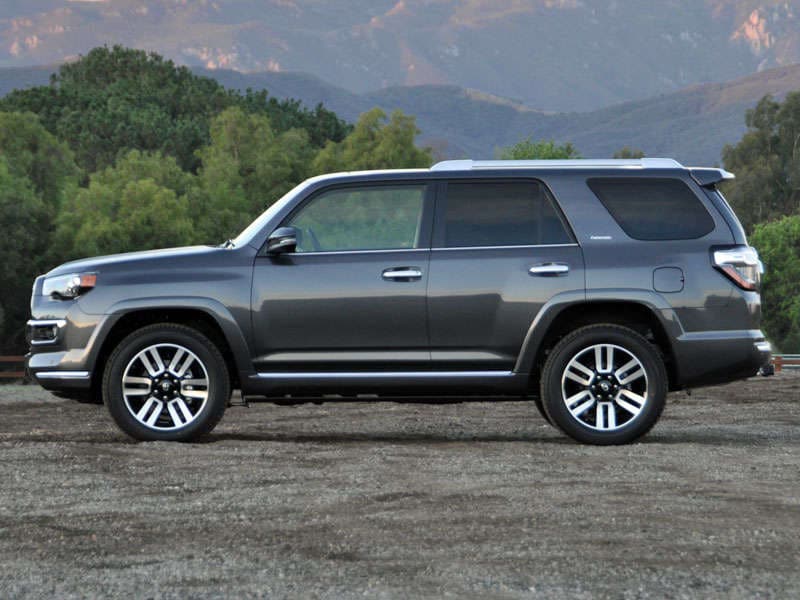Recent Articles
Popular Makes
Body Types
2014 Toyota 4Runner Road Test and Review
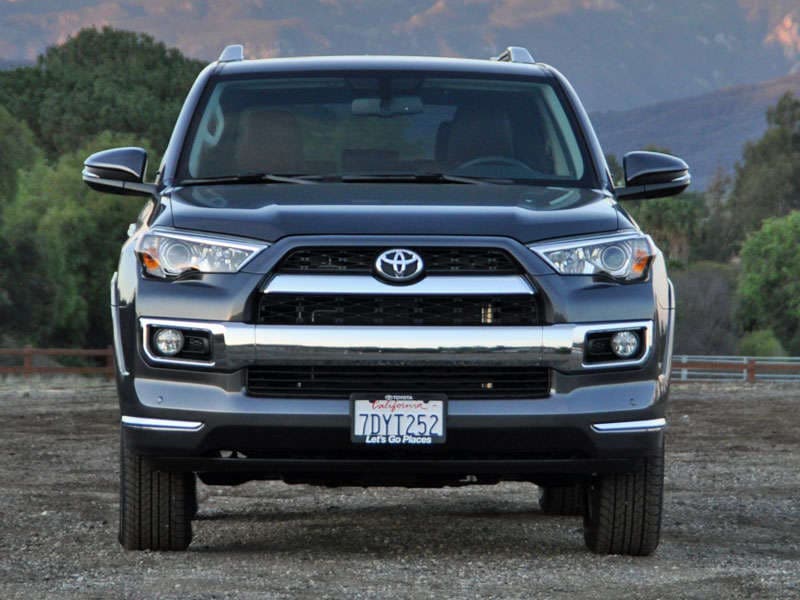
Here’s the problem with moving from Michigan to California, and then marrying a Californian, and then having a family. They all want to go and play in the snow every winter. Personally, I had enough of that crap when I was growing up in Detroit, and I never really got into ice-skating, skiing, snowmobiling, snowboarding, hockey, or any other winter activity that didn’t involve fishtailing or e-brake turns.
As is customary each year, this past week my family coerced me into making yet another annual pilgrimage to see the snow. Only this time around, we had to go quite a distance, since the Los Angeles area is having its driest year in, like, forever, and our local mountains are utterly barren of frozen white stuff. So we packed this 2014 Toyota 4Runner Limited, and headed north to Mammoth Lakes, the rugged SUV proving absolutely perfect for the trip.
Except, of course, for the abysmal fuel economy.
2014 Toyota 4Runner Road Test and Review: Models and Prices
When buying a new 2014 4Runner, you can choose the standard SR5 model ($33,180), the off-road-ready Trail model ($36,585), or the luxuriously loaded Limited model ($42,650).
The SR5 and Limited are equipped with rear-wheel drive, while the Trail has standard 4-wheel drive. A part-time 4WD system is optional for the SR5, while the Limited gets a full-time 4WD system with a locking center differential. All 4WD models include Downhill Assist Control and feature an extra half-inch of ground clearance.
Each of these 4Runner models is well equipped right out of the box. The Trail model adds to SR5 equipment a hood scoop and unique 17-inch aluminum wheels, as well as exclusive features including a Multi-Terrain Select system, a stability control cut-off switch, a locking rear differential, and a Crawl Control system.
The 4Runner SR5 and 4Runner Trail can be optioned with a Premium Package containing SofTex leatherette upholstery, heated front seats, an 8-way power driver’s seat with lumbar support, a 4-way power front passenger’s seat, a power sunroof, and an Entune App Suite infotainment system with navigation.
The 4Runner Limited includes these features plus perforated leather upholstery, ventilated front seats, dual-zone automatic climate control, a Smart Key passive entry system with push-button ignition, a HomeLink universal garage door opener, an auto-dimming rearview mirror, and a JBL premium sound system. The Limited model also gets a redesigned front end with automatic headlights, as well as side mirrors with turn signal indicators and puddle lights integrated into the side mirror housings, front and rear parking assist sensors, and additional chrome exterior trim. An adaptive damping suspension, called a Cross Relative Absorber System (X-REAS), is tucked under the bodywork and the 4Runner Limited rides on 20-inch aluminum wheels.
Inexplicably, the Limited model is also the only version of the 4Runner equipped with Safety Connect telematics with Automatic Collision Notification, SOS Emergency Assistance, Roadside Assistance, and several other useful services. You would think that Toyota would provide this technology across the board, especially for a vehicle designed to go deep enough into the backcountry where getting help is difficult by default.
My 4Runner Limited test vehicle, painted Magnetic Gray with an exceptionally appealing Redwood leather color, included 4WD and a third-row seat for a total of $44,625*.
* All prices include a destination charge of $860
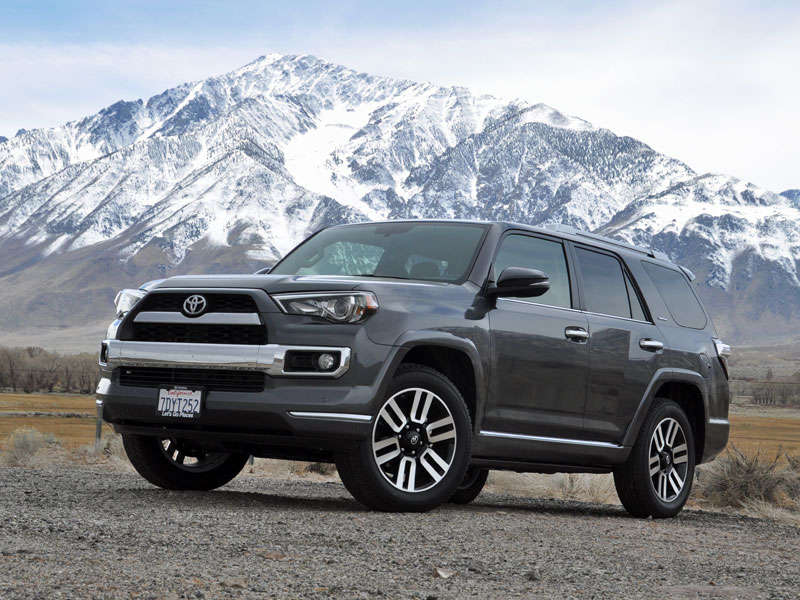
2014 Toyota 4Runner Road Test and Review: Design
- Restyled front end
- New wheel designs and treatments
- Four new paint colors
- Standard roof rack and LED taillights
- Color-keyed trim for Trail model
- Limited gains projector-beam headlights
For 2014, the Toyota 4Runner gets a restyled front end, and my Limited test vehicle’s design details are different from the more aggressive-looking SR5 and Trail models. The Limited has lots more chrome, for starters, and presents a more sophisticated and refined face to the world. It also gets projector-beam headlights and exclusive 20-inch aluminum wheels with machined-face spokes, while all 4Runners have fog lights, LED taillights, and a windshield wiper de-icer system. Under the bodywork, skid plates protect the engine, front suspension, and fuel tank, and if you get 4WD, there’s one covering the transfer case, too.
Previously, I indicated how much I liked my test vehicle’s Redwood leather color, which gives the 4Runner Limited a premium look and feel that the Black and Sand Beige colors do not, mainly because it picks up on highlights in the fake wood installed on the dashboard and on the gear selector. In other respects, the 4Runner’s interior is rather industrial in terms of design, with lots of silver plastic trim and multiple storage cubbies scattered throughout.
Overall, I think the design changes that Toyota has made to the 2014 4Runner are good ones, with the exception of the Trail model. I’m glad that it keeps its sporty hood scoop, but the loss of its blacked-out exterior trim and its previous aluminum wheel design, features which really helped to make it stand out, is a real bummer. Now, the formerly distinctive 4Runner Trail looks just like the SR5.
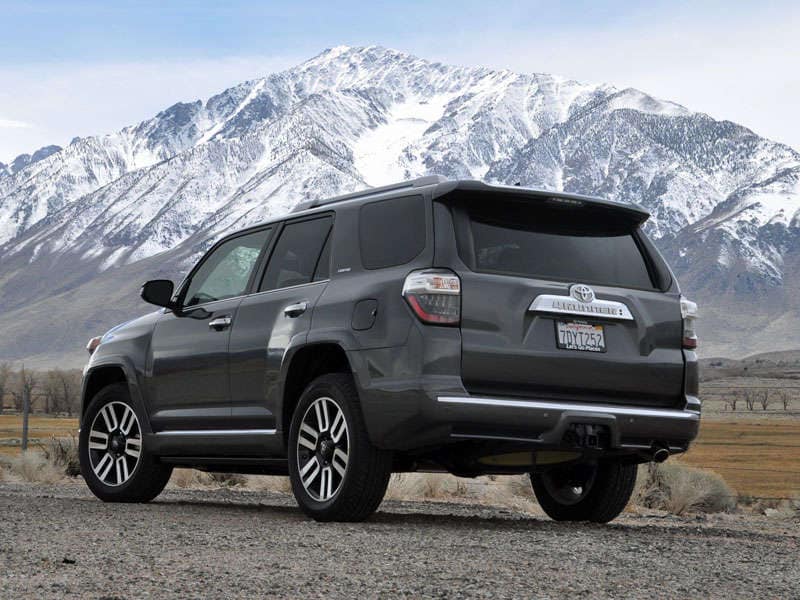
2014 Toyota 4Runner Road Test and Review: Comfort and Cargo
- Upgraded Optitron gauges are standard
- Standard leather-wrapped steering wheel and shift knob
- Soft-touch upper door panel trim added to SR5 and Trail
- Front seat ventilation and memory added to Limited
- New Redwood color for Limited model’s leather seats
Comfort is not a problem with the 2014 Toyota 4Runner. Once you hoist yourself into it, that is, and as long as you’re not crammed into the optional third-row seat. I’ll get to more on that in a minute.
My 4Runner Limited test vehicle featured soft but durable leather and front seats that proved extremely comfortable during my family’s road trip to Mammoth Mountain. The 8-way power driver’s seat delivered a perfect driving position behind the thick-rimmed tilt/telescopic steering wheel, and my test vehicle’s soft upper door panel trim and center armrest added to the 4Runner’s impressive comfort levels. Both front seats were heated and ventilated, features we regularly used while climbing from 80-degree weather in L.A. to sub-zero nighttime temperatures at Mammoth. Visibility proved outstanding, too, with clear sightlines in every direction, aided by a reversing camera system and parking assist sensors.
For a portion of our trip, my wife drove while I rode shotgun in the 4-way power-adjustable front passenger’s seat, tapping furiously at my laptop’s keyboard. Normally I complain when the front passenger’s seat lacks a height adjuster, but I sat in this one for several hours and didn’t miss the omission.
The 4Runner’s back seat is just as comfortable as those up front. Compared to a crossover suv, it might not be as easy to climb into, especially for children, but once you’re seated there’s plenty of legroom, lots of foot room, and good thigh support thanks to the angle of the bottom cushion. A reclining backrest is an appreciated touch.
My test vehicle had the optional third-row seat, which replaces a sliding cargo floor that can support 440 pounds, and which makes both loading heavy cargo and holding tailgate parties much easier. If you elect to equip your 4Runner with the third-row seat, and you’re going to actually use it, prepare for some pain.
The first thing you’ll need to do is remove the available cargo mat and find a place to stow it. Then, get rid of pretty much anything you normally carry because with the third-row seat in use, the 4Runner supplies just 9 cu.-ft. of cargo space. Seriously, that’s not even double the trunk space of a Mazda Miata.
Once that’s done, pull the third-row seatbacks up, deploy the bottom cushions, raise the headrest, and you’re ready to load shorter adults or children. If they need more room for legs and feet, a likely scenario, the second-row seat slides forward to help in this regard, albeit at the expense of that occupant’s comfort. If the front seat passenger is equally magnanimous, somebody with longer legs can fit into the third-row seat and can likely ride for an hour or so without complaining too much, though headroom is at a distinct premium for anyone taller than average height.
Lift the 4Runner’s tailgate, and there’s lots of space behind the back seat. In addition to the 46.3 cu.-ft. of volume, there are handy cubbies and a three-prong power outlet. Also, the high cargo floor and the large rear bumper double as perfect bench seating to use when dressing little kids in their snow gear. If you need to maximize cargo room, fold the back seat down to create an impressive 88.8 cu.-ft. of space.

2014 Toyota 4Runner Road Test and Review: Features and Controls
- Standard Entune touchscreen infotainment system with Bluetooth, satellite radio, USB 2.0 connectivity, and 6.1-inch display
- Available Entune App Suite with access to Pandora, Facebook Places, Bing, and more
- Limited equipped with Entune Premium JBL Audio System with navigation, Entune App Suite, HD Radio, iTunes tagging, and a 7-inch display
- “Party Mode” stereo setting discontinued
Moving beyond issues of comfort, the 4Runner’s controls and displays are idiot-proof, sized to work well while wearing gloves and labeled clearly enough to be understood by people lacking 20/20 vision. The Entune infotainment system’s touchscreen is the exception, equipped with smaller buttons that don’t respond unless you take your gloves off, though the 4Runner Limited model’s larger 7-inch display is preferable to the 6.1-inch display in the SR5 and Trail models.
As for Entune, it works well enough. Big menu buttons line either side of the display, making it easy to find what you’re looking for. Pairing a smartphone took almost no effort, and we had no trouble when using the navigation system to find our hotel. The on-screen buttons are on the small side, though, and glare occasionally makes it hard to see the screen.
At night, the 4Runner’s controls feature a soothing blue glow and my 4Runner Limited had soft front foot well lighting. During the workweek leading up to our road trip, both features unexpectedly served to sooth stress while meeting deadlines prior to departure.
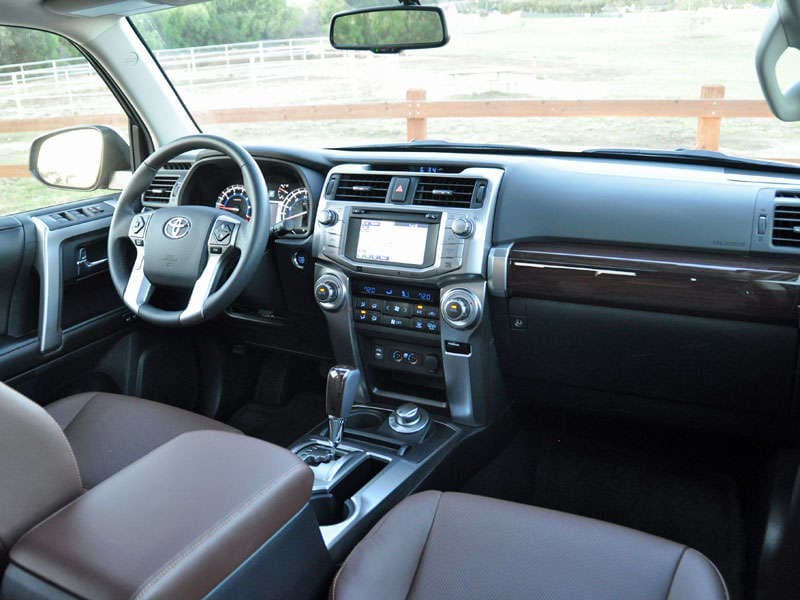
2014 Toyota 4Runner Road Test and Review: Safety and Ratings
- Standard reversing camera
For whatever reason, while Toyota was updating the 4Runner for the 2014 model year, it didn’t take the opportunity to add safety features that are increasingly expected in a modern vehicle. Yes, it has the Star Safety System, one that includes Smart Stop Technology to prevent unintentional acceleration as long as the driver is pressing on the brake pedal, but aside from a standard reversing camera, there’s not much in the way safety gear here.
The one thing I missed the most was a blind spot warning system. A rear cross-traffic alert system also would have come in handy. Since I usually pay attention to my driving and not distractions, I didn’t care that my 4Runner Limited lacked forward collision warning or lane departure warning systems.
The biggest head-scratcher for me, though, is that Toyota provides Safety Connect service only for the Limited model, the one least likely to see serious off-roading adventure. Maybe the theory is that only the people who are paying the most for a 4Runner would be willing to pick up the subscription fee for the Safety Connect service, but my bet is that the off-roading crowd would really love to have an SOS button to push when they get into trouble way out in the middle of nowhere.
If you’re looking for crash-test ratings for a 2014 4Runner, you’re out of luck. The National Highway Traffic Safety Administration (NHTSA) hasn’t tested this SUV, and doesn’t even rate the 4Runner’s rollover resistance capability.
Last year, the Insurance Institute for Highway Safety (IIHS) gave the 4Runner its top rating of “Good” for moderate offset frontal impact, side impact, roof crush strength, and rear-impact injury prevention tests. Those ratings have not translated to the 2014 model as this review is written, despite the fact that the 4Runner is structurally unchanged.
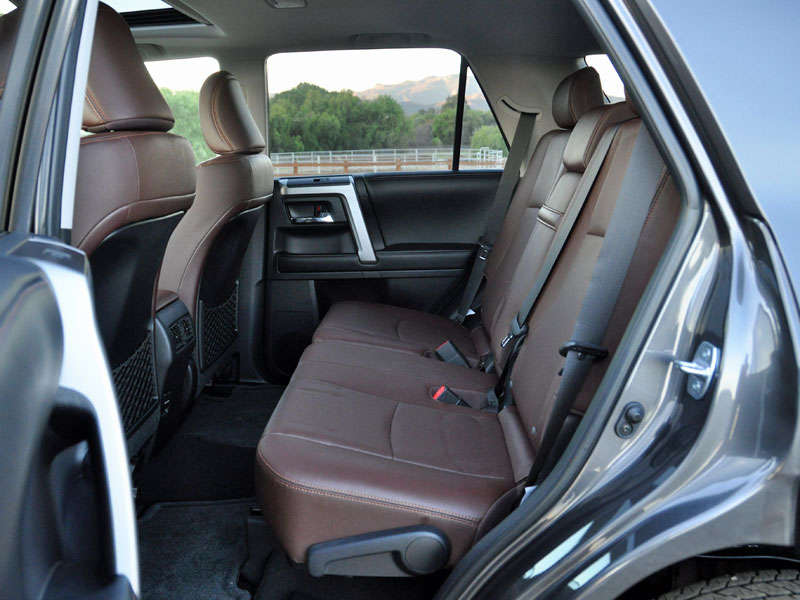
2014 Toyota 4Runner Road Test and Review: Engines and Fuel Economy
- No changes for 2014
A 4.0-liter V-6 engine making 270 horsepower and 278 pound-feet of torque is standard in every 2014 4Runner, along with a 5-speed automatic transmission. Rear-wheel drive is standard for the SR5 and Limited models, while the Trail model is equipped with a part-time 4WD system that includes Active Traction Control. This system is optional for the 4Runner SR5, while the 4Runner Limited can be equipped with a full-time 4WD system featuring Active Traction Control and a locking limited-slip center differential.
As an option for the 4Runner Trail, Toyota offers a Kinetic Dynamic Suspension System (KDSS). This system automatically disconnects the suspension’s stabilizer bars to improve wheel articulation and traction in difficult off-roading situations.
The 4Runner Limited is equipped with a standard X-REAS suspension. Toyota says this setup uses automatically adjustable shocks designed to reduce body pitch and yaw, thereby making the Limited model corner better and ride smoother for a more sure-footed feel on pavement. Google “X-REAS suspension” and you’ll find lots of 4Runner forums discussing how to swap these components out for a standard suspension setup, suggesting that Toyota needs to make it an option for the Limited, rather than standard.
As far as fuel economy is concerned, the EPA says a 4Runner with rear-wheel drive should get 19 mpg in combined driving, and that a 4Runner with 4WD should return 18 mpg. During more than 800 miles of driving, the majority of which were covered on the highways leading to and from the Sierra Nevada Mountains, I got 18.4 mpg.

2014 Toyota 4Runner Road Test and Review: Driving Impressions
Even with its 20-inch wheels and auto-damping suspension, my 4Runner Limited could never be mistaken for anything but a truck. It weighs more than 4,800 pounds, and while the V-6 engine is geared for lots of low-end oomph while off-roading, when you merge onto a fast-flowing freeway it seems to take forever to get up to speed. Once you get to 70 mph or so, nothing about the 4Runner’s driving dynamics says: “Hey, we can make better time than this.” As a result, I cruised up California 395 without once worrying about getting a ticket.
I will admit that the Limited model’s X-REAS suspension and the 20-inch wheels make a difference. This 4Runner felt better planted than the last one I drove, which was an SR5 model of 2012 vintage. But the steering is still really slow and the brake pedal is still mushy and unresponsive upon initial application, traits typical of an SUV designed for genuine off-road travel.
Speaking of off-roading, I didn’t do any in this particular 4Runner. I know, I know, I’m a lousy reviewer, but I had my kids in the car the entire time I had the keys, and the last thing you want is to get yourself stuck in a couple of feet of wet, heavy snow with a 3-year-old and a 5-year-old aboard. I have, in the past, done some pretty serious off-roading in a 4Runner, and this vehicle is a more effective tool in the dirt than most other SUVs, especially in the Trail trim level.
One of my favorite things about driving a Toyota 4Runner is that it does a great impression of a convertible. With the power sunroof open and all four windows down, the effect is just like any other SUV. But the 4Runner has a power rear window, and when you lower that you create flow-through ventilation that’s very similar to a convertible. After our trip to snow country, my final hour with the 4Runner was spent in this fashion, cruising along Pacific Coast Highway on a sunny, 75-degree day.
Now, let’s circle around and address the elephant in the room, shall we? The EPA says a 4Runner with 4-wheel-drive gets 17 mpg in the city, 21 mpg on the highway, and 18 mpg in combined driving. I averaged 18.4 mpg over 800 miles of travel, and 85% of those miles were covered on freeways and rural highways. Granted, I took the 4Runner from sea level to more than 8,000 feet of elevation, but I came back down the same way, so that’s not a factor here.
Needless to say, if you decide that a Toyota 4Runner is perfect for the way you live your life, be prepared to spend lots of time at gas pumps.
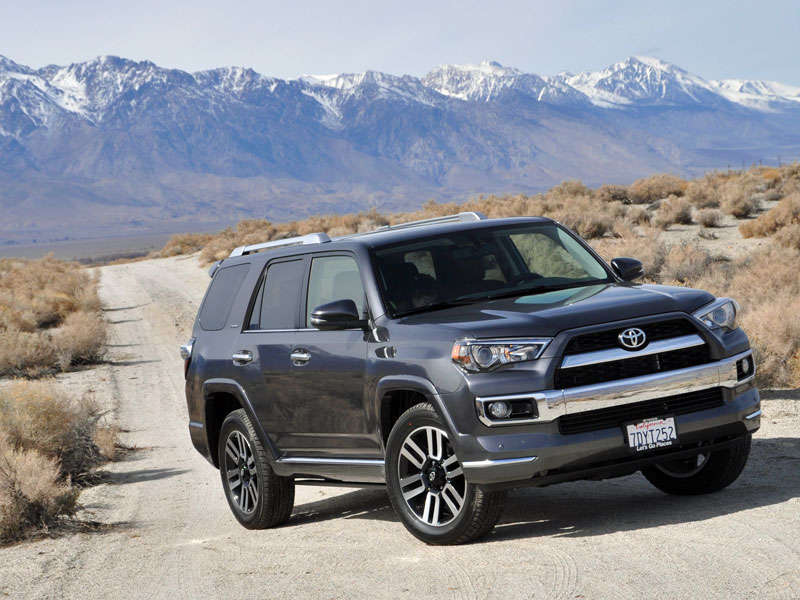
2014 Toyota 4Runner Road Test and Review: Final Thoughts
Because I sit in front of a laptop all day, nearly every day, I’m not a guy who spends a lot of time hiking, or biking, or skiing, or snowboarding, or kayaking, or any number of other physically demanding outdoor activities. Yet, I still love the 2014 Toyota 4Runner, in spite of its terrible gas mileage, because I know that it can go just about anywhere, and do just about anything, nearly any time I want it to.
My bet is that if you’re a truly outdoorsy type, you’ll love the 4Runner, too. Most people, however, are likely better served by Toyota’s other midsize SUV, the Highlander crossover.
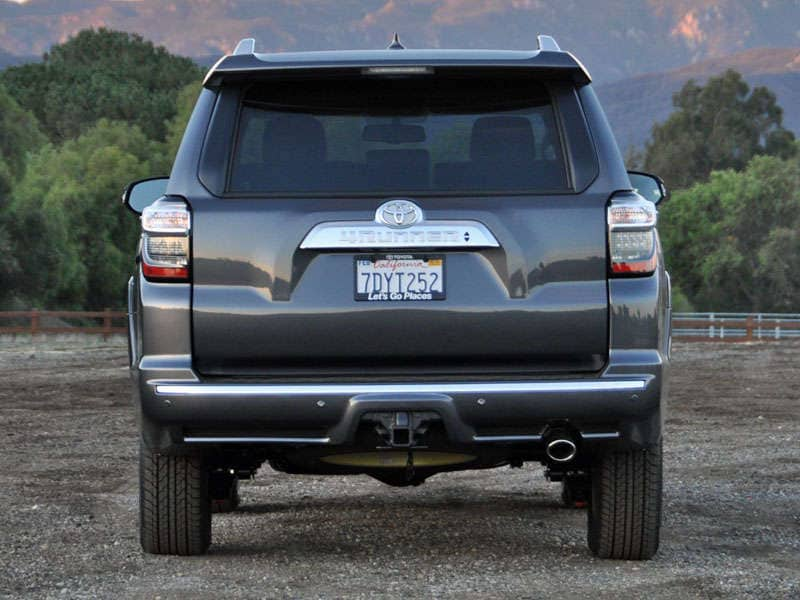
2014 Toyota 4Runner Road Test and Review: Pros and Cons
- Go anywhere, do anything
- Front and rear seat comfort
- Excellent control layout
- Big, useful cargo area
- Power liftgate window
- Lousy gas mileage
- Tall step-in height
- Cramped third-row seat
- Slow acceleration and steering
- Lacks modern safety technologies
Toyota supplied the 2014 4Runner for this review
2014 Toyota 4Runner Limited photos by Christian Wardlaw
